Comprehensive Guide to Cockatiels Care and Insights
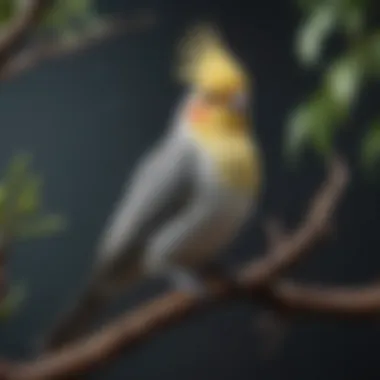
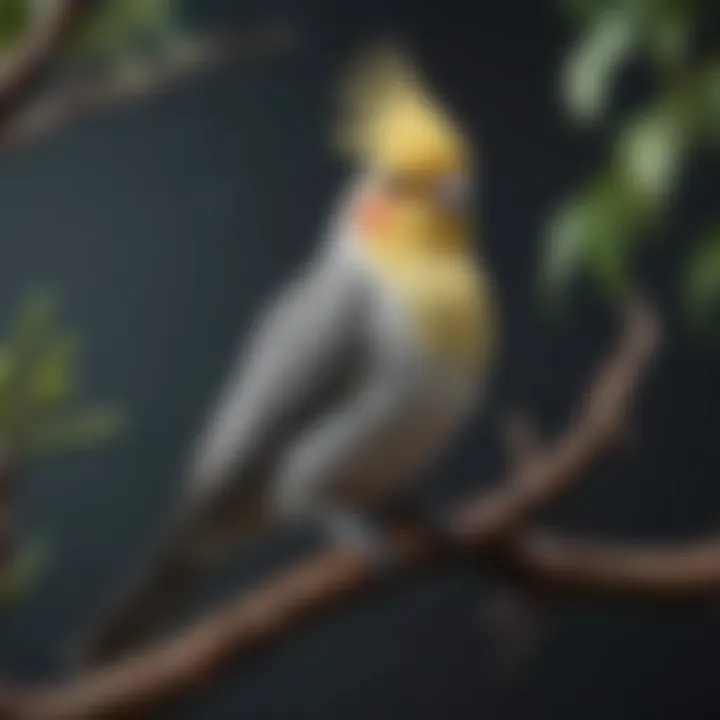
Intro
Cockatiels have nestled into the hearts of many bird enthusiasts across the globe. Their striking appearance, charming personality, and relatively manageable care needs make them a preferred choice for both novice and seasoned pet owners. Yet, embarking on the journey of caring for a cockatiel isn't merely a walk in the park; it demands an understanding of their specific requirements and behaviors, ensuring they thrive in our homes.
This guide aims to demystify the ins and outs of cockatiel care, from the initial selection at your local pet store to establishing a cozy home environment that caters to their needs. We’ll explore daily care routines, cage setups, nutritional needs, and much more. As we delve into this comprehensive narrative, you'll gain vital knowledge to nurture the well-being of your feathered companion. Prepare to enhance your bond and discover the joys of having a cockatiel as your lively partner in life.
Care Tips
Daily Care Routines
Taking care of a cockatiel is like maintaining a well-oiled machine; each part contributes to the smooth functioning of their lives. Every day, ensure your bird has fresh water and a balanced diet. It may feel mundane, but it’s the little things that matter. Spend time interacting with them, observing their little quirks, and checking for any health signs.
Furthermore, leaving your cockatiel out of their cage for a few hours each day offers them necessary socialization and exercise. Watch them flutter about; it’s a sight that can bring a smile to anyone’s face. Remember, “A happy bird is a healthy bird.”
Cage Setup and Maintenance
Choosing the right cage for your cockatiel is equivalent to selecting a cozy home for a family member. It needs to have enough space for them to spread their wings without feeling cramped. A minimum cage size of 24 inches by 24 inches by 36 inches is recommended, but bigger is always better.
Make sure to place perches at different heights, providing them with a climbing gym of sorts. Natural wood perches are preferable as they help with their foot health. Regularly check the cage for signs of wear and tear, cleaning it weekly to keep it inviting.
Hygiene and Cleaning Practices
Maintaining hygiene around your cockatiel is crucial for preventing illness. Wipe down surfaces with a mild vinegar solution and ensure the food and water dishes are cleaned daily. It is all about keeping bacteria at bay while providing a safe haven for your little buddy. Pay special attention to any messes outside the cage as well; a quick cleanup goes a long way.
Seasonal Care Adjustments
As the seasons change, so do the needs of your cockatiel. During winter, they may require a bit more warmth and humidity, while summer might lead to overheating. Regularly check the temperature in your home and adjust accordingly. Perhaps consider a heater or a fan, depending on the season, ensuring that your feathered friend feels comfortable year-round.
Behavioral Insights
Understanding your cockatiel's behavior can feel like cracking a code, but the rewards are well worth it. Each chirp, head tilt, and feather ruffle carries meaning. Pay attention to these subtle cues and you'll navigate the complexities of their world with ease.
Understanding Bird Body Language
Birds, like people, communicate more through body language than words. Look for signs of relaxation, such as fluffed feathers or a calm stance. On the flip side, if your cockatiel is hissing or standing with an upright posture, it signals they might be feeling defensive or scared. Knowing when to give them space is just as crucial as knowing when to engage them.
Common Behavioral Issues and Solutions
While cockatiels are generally amiable, they can throw a curveball now and then. Perhaps they bite when scared or might be prone to excessive squawking. Creating a predictable environment reduces anxiety, which can help manage unwanted behaviors. For biting, gently approach them with confidence, offering a treat to signal trust.
Positive Reinforcement Techniques
When training your cockatiel, think of it as motivating them with rewards rather than punishing them for mistakes. Offer treats or praise when they do something right, and soon enough, they’ll catch on. This method not only builds trust but deepens your bond over time.
Social Interaction Needs
Cockatiels thrive on social interactions, being naturally gregarious creatures. Isolating them for long periods can lead to loneliness, which may result in behavioral hiccups. Ensure your cockatiel has regular interaction, whether it’s through playtime with you or even bonding with another bird. Their social dynamics can make a noteworthy difference in their well-being.
Nutrition Guides
A proper diet is foundational for the health of your cockatiel, playing a direct role in their energy and vitality.
Essential Diet Components
A balanced diet typically includes high-quality pellets, seeds, fruits, and vegetables. Pellets should comprise about 70% of their diet, with seeds serving as an occasional treat. Fresh veggies like leafy greens and carrots enrich their nutrition and offer variety to their meals.
Safe and Toxic Foods
It’s equally critical to be aware of what’s harmful. Foods like avocado, chocolate, and caffeine should be tossed out of their reach immediately. Familiarize yourself with both safe and toxic options, as a little knowledge can prevent a disaster.
Supplements and Treats
Occasional treats, such as nuts or fruits, can be a delightful addition but should be given in moderation. Similarly, consider using vitamin supplements during winter months when the exposure to natural sunlight might decrease.
Feeding Strategies for Different Species
Different species might have varied nutritional needs. Young cockatiels may require a higher proportion of protein for growth, while older birds might benefit from a more fibrous diet. Tailor their intake accordingly, keeping a close eye on their condition.
Wellness and Health
The adage "an ounce of prevention is worth a pound of cure" rings particularly true for our feathered friends. Keeping a close watch on their health is paramount.
Routine Health Checkups
Regular health checkups with an avian vet are like routine maintenance dances for your bird. Keeping on top of their well-being ensures any potential issues are addressed before they escalate.
Identifying Symptoms of Illness
Watch for changes in behavior or appearance. If your cockatiel seems lethargic, has a change in appetite, or exhibits feather plucking, it’s time to reach out to a professional. Being attentive can be the difference between a minor issue and a more significant concern.
Preventative Care and Vaccinations
Just like humans, cockatiels benefit from vaccinations to prevent common diseases. Stay informed about necessary preventative care and ensure your feathered friend receives appropriate medical attention.
Mental and Emotional Well-being
Never underestimate the importance of mental health for your cockatiel. Providing them with stimulating activities and companionship often helps prevent issues like depression and anxiety. Create a space that feels safe and encourages exploration.
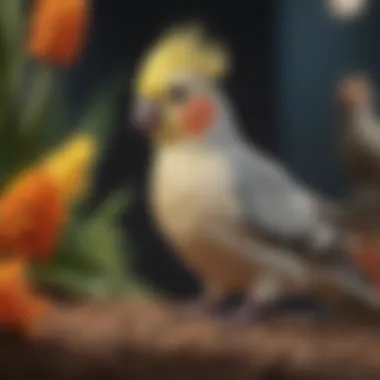
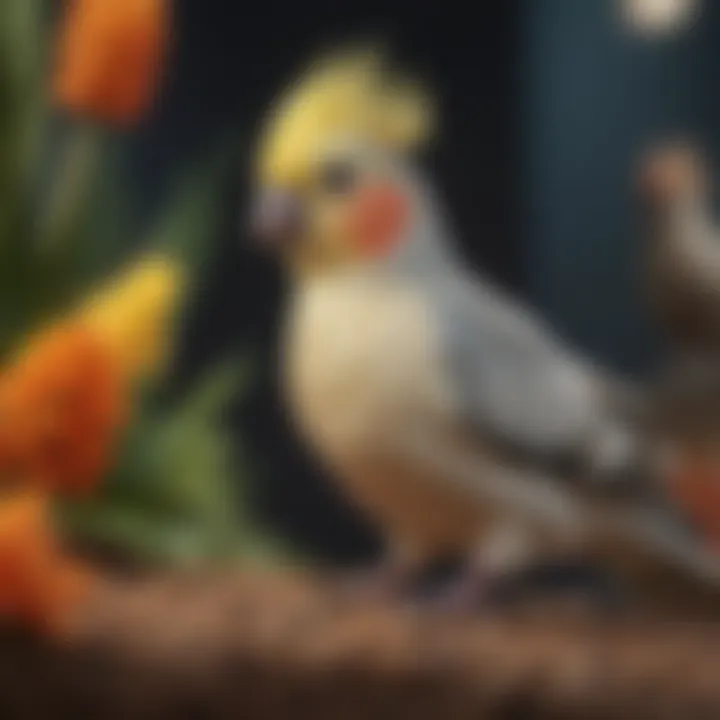
Enriching Activities
Keeping your cockatiel engaged is essential for maintaining their happy disposition. Boredom is an enemy, and offering them a variety of activities is the antidote.
Toys and Playtime Ideas
Consider sourcing different types of toys to provide variety, such as foraging toys or those designed for chewing. Rotate them regularly to keep their interest alive. Interactive playtime with you can also strengthen your bond and keep your feathered friend entertained.
Training and Tricks
Teaching your cockatiel tricks not only promotes bonding but also offers them psychological enrichment. Start with simple tasks, like step-up or wave, gradually building their skill set at their own pace. Patience is key, as trial and error is part of the process.
Outdoor Activities and Interaction
If you live in a safe, enclosed space, consider harness-training your cockatiel. This allows them to experience outdoor environments while still being secure. Fresh air can do wonders for their spirit.
DIY Projects for Mental Stimulation
Crafting DIY toys from household items can keep cost low while enhancing mental stimulation. A simple box with crumpled paper or even a cuttlebone for chewing can lead to hours of amusement.
Engaging with your cockatiel in various ways enriches both their lives and yours. Remember, the time and effort you invest reap rewards tenfold!
Understanding Cockatiels: An Overview
When you’re planning to add a cockatiel to your family, diving into its characteristics and history is nothing short of essential. Understanding cockatiels gives you a solid foundation for making informed decisions about their care and bonding. These feathered companions are not just pets; they bring joy and color into homes, but they also come with their own unique needs and quirks.
The cockatiel, a species of parrot, originates from Australia. They’ve been kept by humans for years, and their popularity continues to swell due to their amicable nature and intelligence. Knowing where they come from can provide insight into their behavior. For instance, cockatiels are known to be quite social in the wild, living in flocks, which is something that owners need to keep in mind when introducing them to their homes.
In addition to history, grasping their physical characteristics helps in understanding what makes these birds unique. From their vibrant feather patterns to their distinctive crests, each feature plays a role in their behavior and interactions with humans.
Having a well-rounded understanding of cockatiels helps you appreciate them more deeply. It allows for better decision-making regarding care, training, and social interaction, ensuring a fulfilling relationship with these captivating creatures.
Origin and History
Cockatiels belong to the parrot family and are native to the arid regions of Australia. Their history is rich, stretching back thousands of years. Historically, these birds inhabit various environments including grasslands and woodlands, which influences their behavioral patterns.
The first formal mention of cockatiels dates back to the early 1800s when ornithologists began documenting them. They were brought to Europe where their charm quickly won the hearts of many. Over the years, selective breeding has resulted in various color mutations like lutino, pied, and cinnamon. These variations have broadened their appeal among bird enthusiasts.
Today, cockatiels are one of the most popular pet birds worldwide. Their stories are not just about being domesticated; it’s about how they adapted to different surroundings while still maintaining their inherent traits, which is quite remarkable.
Physical Characteristics
Cockatiels are relatively small birds, averaging about 12 to 14 inches in length. One of the most striking features is their crest, which stands upright when they’re excited or curious. This crest can also droop when they are not feeling well. The body of a cockatiel is typically slim, aiding in their agility around the cage or during flight.
Their plumage comes in various colors, including gray, white, yellow, and orange, largely depending on their mutation. The cheek patches, bright and vibrant, serve not just for looks but also play a role in communication.
Additionally, cockatiels possess a robust, strong beak suited for cracking seeds—a staple in their diet. Their feet, zygodactyl in nature, allow them to grip and perch effectively on various surfaces.
Understanding these physical features is critical, as it gives insight into their needs, behavior, and how to interact with them.
Their physical traits, along with their charming personalities, make cockatiels not just pets but family members that require love and attention. Each characteristic, from their sociable demeanor to their playful antics, emphasizes why they need an engaging environment and adequate interaction from their owners.
Selecting the Right Cockatiel from a Pet Store
Selecting the perfect cockatiel is a crucial step that can affect the quality of your relationship with your new feathered friend. Not only do you want a healthy bird, but also one with a personality that matches your lifestyle. Taking the time to understand what to look for in a cockatiel at a pet store can pay dividends in bird happiness and owner satisfaction.
Assessing Health and Behavior
When approaching your future cockatiel, it’s important not to rush into a decision. Observing the health and behavior of a bird is your first step. A well-cared-for cockatiel will typically exhibit a keen interest in its surroundings. Look for signs of alertness: bright eyes, smooth feathers, and an outgoing demeanor are all good indicators.
Here’s a quick list of health signs to watch for:
- Feather Condition: Look for a bird with smooth, unruffled feathers. Any signs of bald patches or excessive plucking should be a red flag.
- Eyes: They should be bright and clear without any discharge.
- Nose: A clean nostril area is a positive sign; discharge could indicate health issues.
- Behavior: Friendly contact-seeking behavior will make for a more engaging companion. If the bird seems excessively withdrawn or hostile, think twice.
In all, a proactive assessment could not only lead you to a healthy pet but also prevent you from facing heartache down the road.
Choosing the Right Age and Gender
The age of a cockatiel often affects its temperament and ease of training. Younger birds, generally around 8 to 12 weeks old, tend to bond more easily with their owners. However, they may also require more patience as they learn the ropes of their new environment. On the flip side, adult cockatiels, past their initial growth stage, might be less demanding in terms of training but can be more set in their ways.
Gender can also play a crucial role:
- Male Cockatiels tend to be chirpier and often learn to whistle more tunes, which can be a delightful addition to your home.
- Female Cockatiels might be quieter and a bit more reserved in personality. They can also be more prone to hormonal issues, which can affect their behavior.
In short, choosing between age and gender will come down to the type of relationship you wish to create.
Understanding Breeders vs. Pet Stores
When setting your sights on acquiring a cockatiel, you will face a decision: go with a breeder or a pet store? Breeders often have a more specialized knowledge of their birds' backgrounds and can provide you with extensive insight into the parent birds' health and temperament. They often raise the birds in a more nurturing environment and might prioritize socialization more than a pet store.
On the other hand, pet stores can be convenient. You can see a variety of different breeds and colors in one visit, which is appealing. However, the care conditions can vary widely, leading to potential health issues. When opting for a pet store, inquire about their care practices and whether they have a vet on staff or a health guarantee for their birds.
Remember: The right choice now can lead to years of compatible companionship later on.
Setting Up Your Cockatiel's Environment
Creating the right environment for your cockatiel is a cornerstone of their well-being. An optimal habitat doesn't just provide shelter; it significantly impacts their physical health and emotional stability. A lovingly arranged space acts as a foundation for your feathered companion to flourish. Recognizing the subtleties of this setup is essential, especially for newcomers to bird ownership. That means paying attention to specifics like cage size, accessories, and layout. By doing so, you can ensure your cockatiel leads a vibrant, enriched life.
Cages: Size and Structure
When it comes to selecting a cage, size matters a lot. Cockatiels are moderate-sized birds and need enough room to spread their wings and move comfortably. A cramped cage can lead to stress and health issues down the line. Aim for a cage that's at least 24 inches wide, 24 inches deep, and 36 inches tall. Keep in mind, a spacious structure allows for various activities—climbing, flying, and just hanging about.
The cage should also have horizontal bars. Cockatiels love to climb, and horizontal bars provide better grip for their little feet. Additionally, avoid cages made from toxic materials; opt for non-toxic, powder-coated steel or stainless steel.
"A good cage is like a nice home—enough space for freedom but safe enough for peace of mind."
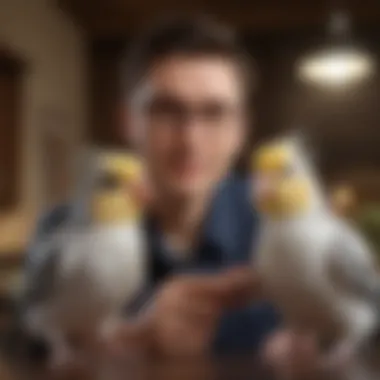
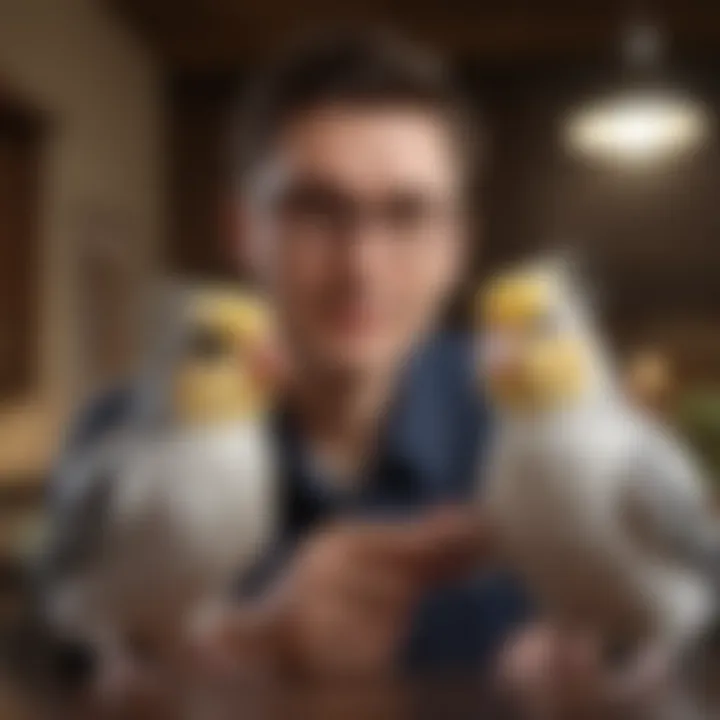
Essential Cage Accessories
With the right cage in place, now it’s time to deck it out with some essential accessories. Providing a range of perches is vital for foot health. Vary the diameter and texture of these perches, as they help exercise their feet and prevent injuries. Natural wood perches are great for this as they mimic the wild environment.
Don't forget food and water dishes. Look for sturdy, size-appropriate feeders that are easy to clean. Also, a cuttlebone is beneficial for beak health and provides necessary calcium. Adding chewable toys is a win-win; it keeps your cockatiel entertained and prevents boredom. Here’s a quick list of must-have accessories:
- Cuttlebone: For calcium and beak care.
- Various Perches: Natural wood for foot exercise.
- Toys: To stimulate play and cognitive activity.
Creating a Safe and Engaging Space
Beyond just cages, consider the overall setup. Cockatiels are intelligent and social creatures; thus, their environment should be engaging. Hang toys at different heights in the cage to encourage exploration. Rotate them regularly to maintain interest. It’s also a good idea to create a designated play area outside the cage—that gives them more freedom to flap their wings and push the boundaries of their curiosity.
Safety is equally important. Remove any potential hazards such as toxic houseplants, small objects they could swallow, or sharp edges within their reach. Regularly check for any loose cage components or wear and tear.
In summary, your cockatiel's environment should stock up on space, variety, and safety. When they feel secure and stimulated, you'll find that their personality shines even brighter. By taking the time and care to create a thoughtful setup, you're not just accommodating a pet—you're nurturing a companion.
Nutrition and Diet for Cockatiels
A healthy diet is the cornerstone of your cockatiel’s well-being. Just like any living creature, cockatiels need proper nutrition to thrive, maintain their feather quality, energy levels, and overall health. A balanced diet not only keeps your feathered friend happy but can also prevent diseases that could turn into serious issues down the line. So, let’s break down the essential elements of diets for these charming birds.
Understanding Dietary Needs
Cockatiels, being predominantly herbivorous, have specific dietary requirements. Their digestive systems are built to process seeds, fruits, and vegetables, so it's crucial to provide a mix that caters to their needs. Their diet should ideally consist of:
- Pellets: While seeds are popular, approximately 70% of their diet should come from quality pellets. These pellets are specially formulated to offer essential vitamins and minerals.
- Seed Mixes: High-quality seed mixes can be offered, but be careful with the quantity. Too much can lead to obesity.
- Fresh Fruits and Vegetables: A key part of their diet includes fresh produce, which adds vital nutrients.
By understanding these dietary needs, we set the foundation for a healthy lifestyle. Just as we enjoy a varied diet, cockatiels do best when they can nibble on a little bit of everything, keeping their taste buds and minds engaged.
Choosing Quality Pellets and Seeds
When it comes to food, quality trumps quantity, without a doubt. Selecting high-quality pellets means you’re giving your cockatiel the best chance at a long life. Look for pellets that are appropriate for their size and age. Many brands boast a balance of protein, fat, and fiber – this is crucial.
- Avoid seed-only diets: Many first-time owners may default to seed blends, which aren’t nutritionally complete. Seeds can be high in fat but low in vitamins.
- Avoid dyes and artificial flavors: Some cheap brands include these, thinking they’ll make the food more appealing. In truth, they can have negative effects on your pet’s health.
Remember, just like you don't want junk food every day, your cockatiel also deserves better than the bottom shelf options. Opt for brands with a good reputation in the pet community, perhaps checking recommendations from forums or local breeders.
Introducing Fresh Foods and Treats
Adding fresh foods to your cockatiel's diet can be like throwing a party for their taste buds. Yet, introducing this new aspect should be done gradually to avoid digestive upset. Start with small pieces of fruits like apples, carrots, or leafy greens. Observe how your bird reacts.
Some fresh foods to consider:
- Leafy greens: Spinach, kale, or romaine.
- Fruits: Apples (without seeds), bananas, and berries in moderation.
- Vegetables: Carrots, sweet potatoes, and bell peppers.
However, not all human foods are safe for cockatiels. Avoid avocados and chocolate, as these foods are toxic to birds. Keeping a close eye initially helps to nip any digestive woes in the bud. Besides, seeing your cockatiel enjoy these vibrant treats can become incredibly rewarding.
"A varied diet is the spice of life for your cockatiel. Just as we crave different tastes, they thrive on variety!"
With a solid understanding of cockatiels' nutrition and diet, you're well on your way to fostering a happy, healthy bird. Taking care of what goes into their little bodies will bring benefits that are all too apparent in their vibrant personality and zest for life.
Establishing a Bond with Your Cockatiel
Building a strong relationship with your cockatiel is not just about ownership; it's about understanding and nurturing a connection that can last for years. Establishing a bond is vital because it ensures that your bird feels secure, loved, and becomes more interactive. An affectionate cockatiel can turn your home into a vibrant space filled with delightful chirps and companionship.
Understanding Cockatiel Behavior
To develop a profound bond with your cockatiel, knowing their behavior isn’t just beneficial—it’s essential. Cockatiels are social creatures, and understanding their body language can provide insights into how they feel. When a cockatiel fluffs up its feathers, it indicates contentment; conversely, if it ruffles its feathers or puffs its chest, it might be stressed or scared.
Observing their vocalizations is another key. Each sound means something. A soft chirp can indicate happiness while louder, harsher calls might signal distress or a call for attention. By attuning yourself to these nuances, you can respond more effectively to your pet's needs, which is a building block for trust. As they say, "Actions speak louder than words," and your willingness to respond sensitively gives your cockatiel a solid reason to trust you.
Techniques for Training Cockatiels
Training isn’t just about commands; it's about strengthening your bond. Start with simple techniques like positive reinforcement. Offering treats for good behavior creates a rewarding environment for your cockatiel.
- Step-up Training: This is fundamental. Gently encourage your cockatiel to step onto your finger using a treat.
- Recall Training: Have a specific word or whistle that signals your bird to come to you. Be consistent.
- Trick Training: Simple tricks can be a fun way to engage your bird and reinforce bonding. Try teaching them to wave or spin.
Patience is crucial here. Birds learn at their own pace. Celebrate small milestones, and soon enough, your cockatiel will exhibit behaviors that reflect their attachment to you.
Importance of Social Interaction
Social interaction plays a pivotal role in a cockatiel's emotional well-being. Regular interaction with your bird results in a healthier, happier creature. Whether it’s chatting while they’re perched on your shoulder or allowing them to explore a safe area of the house, these minutes count.
Cockatiels are known for their llama-like traits; they thrive on attention and will quickly become bored or lonely without it. Make it a point to spend at least some time daily engaging them. Provide toys or puzzles that stimulate their minds, or consider having another bird, but don’t forget your role in their social circle. Your presence is irreplaceable, and no toy can replace the bond established through personal interaction.
"A happy cockatiel is one that feels loved and secure in its environment."
To sum it up, establishing a bond with your cockatiel is much more than feeding and housing them. It’s an intricate dance of understanding their emotions, patiently training them, and ensuring that they never feel alone. Both parties, the cockatiel and you, grow together, paving the way for years of combined joy and companionship.
Health and Wellness Considerations
Understanding the health and wellness of cockatiels is crucial not just for their longevity, but for their overall happiness and behavior. Much like us, these charming creatures are susceptible to a variety of ailments that can stem from poor diet, insufficient care, or inadequate living conditions. As a pet owner, it’s imperative to stay attuned to both the physical and psychological needs of these birds. By fostering an environment that supports their health, you're also nurturing the bond between you and your feathered companion.
Regular Health Check-ups
Regular health check-ups are essential for your cockatiel. Much like a routine visit to the doctor, a vet visit can help catch potential problems early on. Cockatiels can be quite stoic, often hiding ailments until they become severe. Scheduling annual visits with an avian vet can help ensure your bird remains in tip-top shape.
When you bring your cockatiel in for a check-up, expect the vet to perform a thorough examination. They might check for:

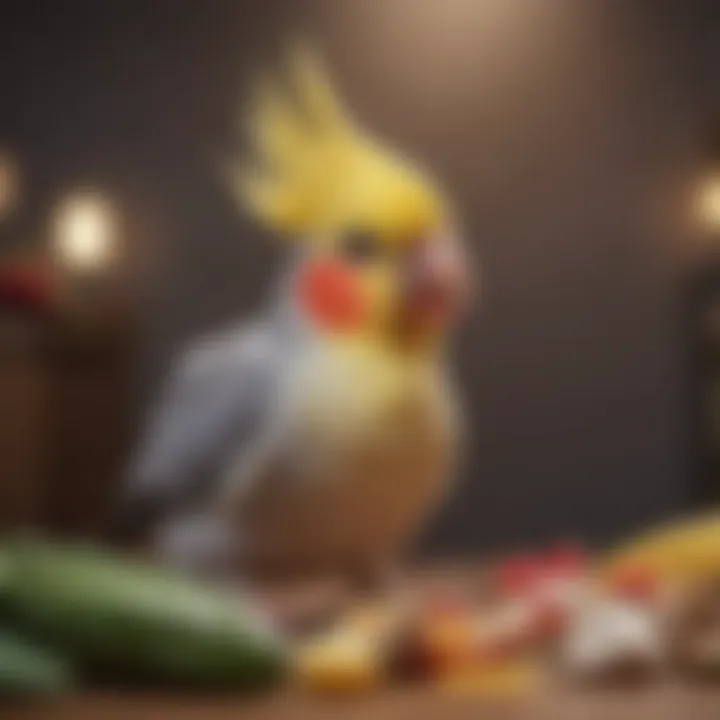
- Feather condition: Tattered or over-preened feathers can indicate stress or illness.
- Weight: Sudden weight loss or gain can be a sign of health issues.
- Beak and nails: Overgrown beaks and nails can affect their ability to eat and move.
- Droppings: This can reveal a lot about your cockatiel's health.
Keeping a close eye on your cockatiel’s behavior along with routine checks can prevent minor issues from escalating into something more serious.
Common Cockatiel Health Issues
Cockatiels, like any pets, can face a range of health concerns. Being aware of these problems can help in identifying issues early. Some common health issues include:
- Psittacosis: This infectious disease can cause respiratory issues and must be treated swiftly.
- Feather plucking: Often linked to stress, boredom, or health issues, this can lead to serious emotional and physical ramifications.
- Obesity: A result of improper feeding or lack of exercise, obesity can lead to other health complications.
- Respiratory infections: Signs include wheezing or labored breathing. Good air quality is essential for prevention.
Being knowledgeable about these issues allows you to react promptly and seek veterinary assistance when necessary.
Preventative Care Strategies
Prevention is the best medicine. Adopting a proactive approach to your cockatiel's health will contribute significantly to their well-being. Here are some preventative care strategies you can implement:
- Balanced Diet: Ensure that your bird's diet consists of a mix of high-quality pellets, seeds, and fresh fruits and vegetables. This diversified diet is essential for their nutrition.
- Clean Environment: Regularly clean their cage and surroundings to minimize the risk of disease.
- Social Interaction: Spend time with your bird every day. Social isolation can lead to stress-related issues.
- Enrichment Activities: Provide toys and activities that engage their minds, reducing boredom that can lead to behaviors such as feather plucking.
- Quarantine New Birds: If you introduce a new bird to your home, keep it separate from your existing cockatiel for at least 30 days to prevent potential disease transmission.
"An ounce of prevention is worth a pound of cure."
Implementing these strategies will not only keep your cockatiel healthy but also enhance the quality of life you both share.
Recognizing Signs of Stress or Illness
Understanding when your cockatiel is feeling under the weather or stressed is crucial for ensuring they lead a healthy, happy life. Just like humans, birds can exhibit changes in behavior when they’re feeling low. Recognizing these signs isn’t merely a matter of being a responsible pet owner; it’s about forming a deeper bond with your feathered friend. Being aware of their behavior allows you to intervene in a timely manner, safeguarding their physical and mental health.
Behavioral Indicators
Behavioral changes can often serve as a red flag for cockatiels. Unlike a simple cold, stress or illness often manifests through subtle shifts in their usual demeanor. Watching for these indicators can save you a lot of heartache.
- Plucking Feathers: One of the more noticeable signs of stress or discomfort is feather plucking. If your cockatiel is suddenly looking ragged, it might not just be a passing phase.
- Lethargy: A normally active bird who spends most of the day motionless could be sending you a distress signal.
- Changes in Vocalization: If your cockatiel suddenly stops chirping or becomes too quiet, or conversely, if they begin to squawk incessantly, it’s worth taking note.
- Aggression or Withdrawal: More aggressive behavior or withdrawal from interaction can indicate something amiss, whether it's stress linked to their environment or a sign of illness.
Understanding these behaviors can empower you to create a nurturing environment. If you notice one or several of these indicators, it's wise to evaluate their surroundings for stressors, be it loud noises, other pets, or simply a lack of interaction.
Physical Symptoms to Watch For
Beyond behavioral cues, physical symptoms can provide vital insights into a cockatiel's health status. Here’s what you should keep an eye on:
- Changes in Appetite: A sudden drop or increase in eating habits may signal a health issue. Keep track of what's typical for your pet.
- Weight Fluctuations: Regularly check if they’re gaining or losing weight—significant changes can indicate either a medical concern or emotional distress.
- Unusual Droppings: The state of your cockatiel's droppings can reveal a lot; watch for changes in color, consistency, and frequency.
- Nasal Discharge or Watery Eyes: Discharge can be a sign of respiratory issues or other health problems, requiring quick action.
- Fluffed Up Feathers: While birds may fluff themselves to keep warm, persistent puffiness could indicate illness.
"A bird in distress often will sit still, fluff its feathers, and avoid contact. Understanding these signs is your first step in caring effectively for your pet."
Keeping a close watch for both behavioral and physical indicators allows you to act promptly. If you notice any concerning signs, consider consulting a vet who specializes in avian care. By remaining vigilant and understanding your cockatiel's normal behavior, you can help them live a longer, healthier life.
Enriching Activities for Cockatiels
When it comes to keeping cockatiels happy and healthy, engaging them in various activities is crucial. Enriching activities stimulate their minds and provide a sense of fulfillment, ensuring their well-being and reducing the likelihood of behavioral issues. Just like us, these birds need a dash of excitement in their day-to-day routine. This section will dive into specific types of enrichment, focusing on toys, interactive play, and social opportunities.
Toys for Cognitive Stimulation
Providing your cockatiel with the right toys can be a game-changer in promoting cognitive health. Often, a bored cockatiel might develop habits that are less than desirable, like excessive screeching or feather-picking. To avoid these behaviors, consider integrating an array of toys that challenge them intellectually.
- Types of Toys to Consider:
- Puzzle toys that require problem-solving skills, such as those that hide food or treats.
- Foraging toys encourage the natural instinct to search for food, keeping them engaged for longer periods.
- Chewable toys are a hit, as cockatiels love to gnaw, and it helps in maintaining their beak health.
Tip: Rotate toys regularly to maintain novelty. Cockatiels can quickly lose interest if they see the same toys every day.
Interactive Play Techniques
Engaging in interactive play is one of the most fulfilling ways to bond with your cockatiel. Simple activities can enrich their environments and establish deeper connections. Here are some techniques worth considering:
- Target Training: This involves using a stick or finger to guide your bird to a desired location, rewarding them with treats when they follow correctly. This builds communication skills and strengthens the bond between you and your feathered friend.
- Fetch: Believe it or not, some cockatiels can learn to fetch small items like crumpled paper balls. This play engages their instincts and can be quite amusing for you to observe.
- Hide and Seek: Hiding treats within their cage or around the room can motivate them to explore. This is a simple yet effective way to encourage exercise and mental stimulation.
Socialization and Interaction Opportunities
Cockatiels are naturally social creatures. Incorporating social interaction into their daily routine not only keeps them entertained but also helps in developing their social skills. Here are a few methods to foster socialization:
- Regular Contact: Spend quality time with your bird daily, talking softly or singing. Your voice becomes a source of comfort, helping them to feel secure in their environment.
- Introducing New Faces: Carefully introducing friends or family to your cockatiel can enhance their social exposure. Monitor how your bird reacts, and if they seem comfortable, allow them to engage further.
- Bird Playdates: If you know other bird owners, setting up playdates can be enriching. Just ensure that all birds are healthy and vaccinated before mixing them together.
Incorporating these enriching activities into your cockatiel's daily life is essential for their mental and emotional well-being. Whether through stimulating toys, interactive play, or socialization opportunities, keeping your feathered friend engaged ensures a happy and healthy life.
By combining these various elements into your routine, you will not only enhance your cockatiel's quality of life, but also lay the groundwork for a fulfilling relationship that you both cherish.
Final Thoughts on Cockatiel Ownership
Owning a cockatiel is a journey filled with joy and learning. As delightful as these birds can be, it’s imperative to acknowledge the profound responsibility that comes along with welcoming them into your home. Cockatiels aren't just pets; they can be companions and friends that require care akin to that of small, sentient beings. This section focuses on the essence of commitment and the practicalities of long-term care, which will ensure that both bird and owner have a harmonious relationship.
Commitment and Responsibility
The commitment required for cockatiel ownership isn't merely about feeding and cleaning their space. It goes deeper than that. Here, you must embrace the notion that you're taking on a living being that thrives on interaction, mental stimulation, and social bonding.
- Daily Interaction: Cockatiels need daily engagement. Ignoring them can lead to behavioral issues, such as biting or excessive screaming.
- Understanding Their Needs: Creating a comfortable environment, choosing the right diet, and providing toys for stimulation are fundamental. Hickups in any of these areas can manifest into unhappiness or stress for your bird.
- Long Term Commitment: Cockatiels can live anywhere between 10 to 15 years, sometimes even longer. This is a long-term commitment that can drastically change your lifestyle.
Even before purchasing a cockatiel, aspiring owners must reflect on their ability to provide attention consistently. Investing time in understanding their individual personality can go a long way—each bird is as unique as the human who cares for them. This commitment to responsibility will lead to a happier coexistence.
Long-term Care Expectations
Once you've set the stage for cockatiel ownership, it’s crucial to maintain high standards of care throughout their lifespan. Here we break down what you realistically need to consider when embarking on this journey.
- Veterinary Care: Regular health check-ups are essential to detect any potential health issues. A vet familiar with avian care is vital.
- Dietary Needs: Over time, their dietary requirements may shift. Understand and adapt as necessary, introducing new foods gradually. Fresh fruits and veggies are great additions that can make their diet more exciting.
- Environment Enrichment: Keeping their living space stimulating is imperative. Rotate toys and change the layout of their cage occasionally to keep things fresh and interesting.
- Training and Interaction: This is a continuous aspect. Regular training sessions can improve their behavior and develop a deeper bond between you two.
"A cockatiel's mood can mirror the environment you provide. Happy environments lead to happy birds."
In summation, being prepared for long-term care means being proactive rather than reactive. It's not just about having a pet; it’s about being their guardian, ensuring their wellbeing, and enjoying the rewarding love they bring into your life. Understanding the seriousness of this commitment will pay dividends in your relationship with your feathered friend.















